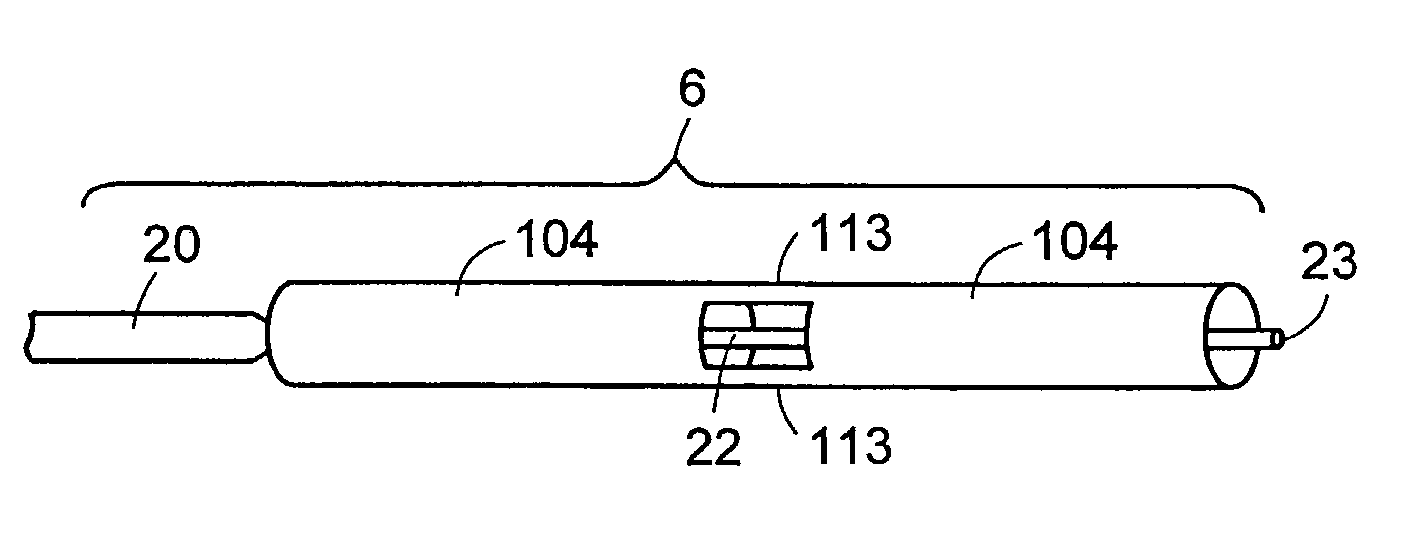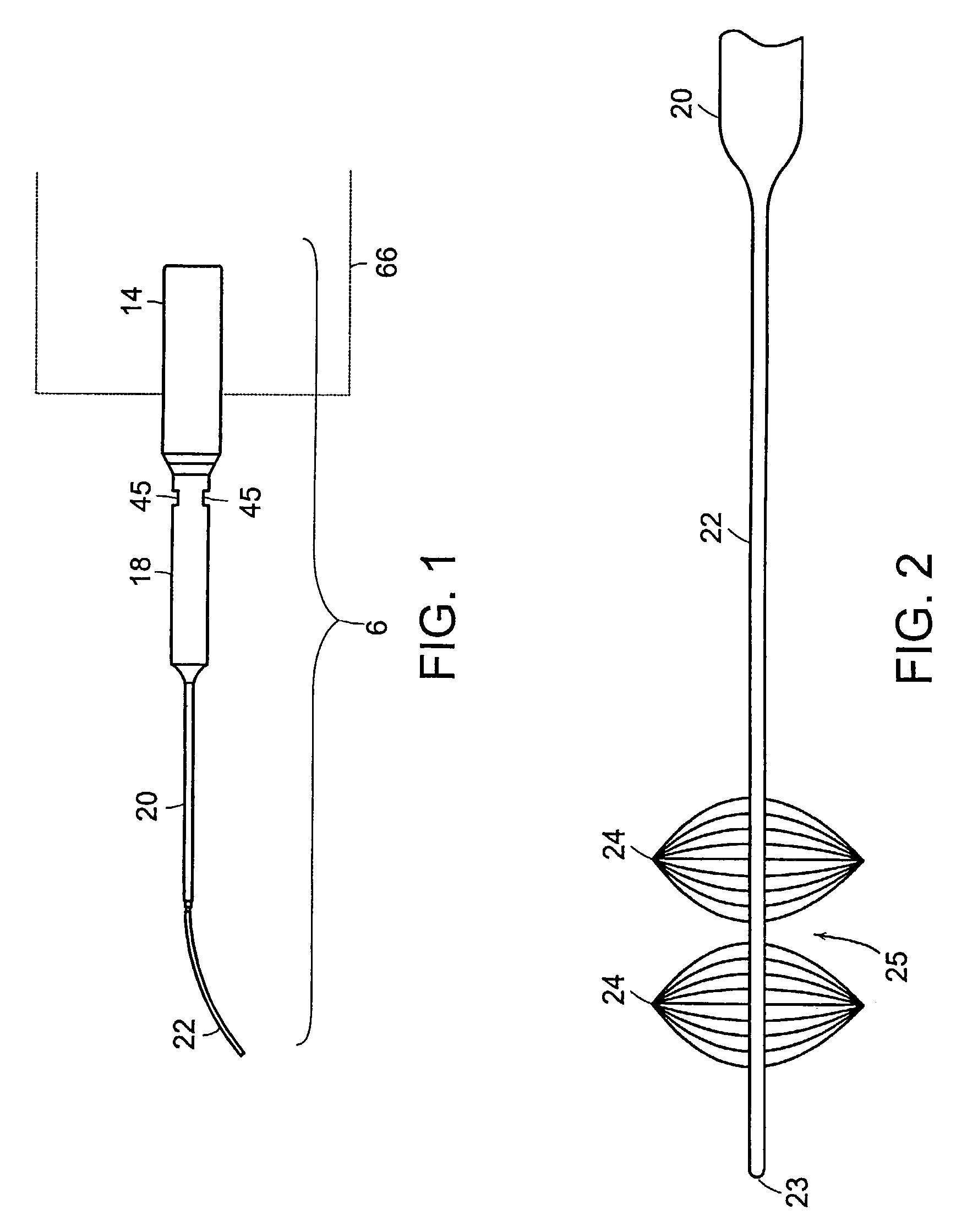[0013]Further in accordance with the invention, a sheath, a sleeve or other damping member provided with fenestrations is a sheath that is adapted circumferentially along the probe axis, thereby providing control over release of
cavitation energy in specific regions along the probe axis. Non-fenestrated areas of the said sheath or sleeve effectively block cavitation energy emanating from the probe from such areas.
[0015]In one aspect, a plurality of sheaths are used in combination to provide another level of precision control over the direction of cavitation energy to a tissue in the vicinity of the probe. In one embodiment of the invention, the sheath encloses a means of introducing fluid into the site of the procedure, and a means for aspirating fluid and tissue debris from the site of the procedure. In another aspect the sheath
assembly further encloses a means of introducing a
drug intravascularly that dissolves clots and prevents the recurrence of
stenosis. The
ultrasonic oscillation of the probe of the present invention will be used to facilitate the penetration of antithrombogenic agents into the vascular or luminal walls to inhibit
restenosis. Preferred antithrombogenic agents include
heparin,
hirudin, hirulog,
urokinase,
streptokinase, tPA, and similar agents. In a further embodiment, the probe tip can be moved within the sheath. In yet another aspect, the
irrigation and aspiration means, and the probe tip, can all be manipulated and repositioned relative to one another within the sheath. In another embodiment, the sheath is shaped in such a way that it may capture or grasp sections of tissue that can be ablated with the probe.
[0016]Still further in accordance with the invention, the sheath provides a guide for the probe tip, protecting tissues from accidental puncture by the sharp, narrow-
diameter tip, or from destruction by energy emitted radially from the probe during introduction of the probe to the site. The sheath may be applied either to the probe tip prior to
insertion of the probe into the patient, or pre-inserted into the patient prior to the
insertion of the probe. The sheath of the present invention can be used to fix the location of one or more shapes relative to the nodes or anti-nodes of a probe acting in transverse action. The location of the reflective shapes can amplify the acoustical wave thereby magnifying the energy. This allows for the use of very small
diameter probes which themselves would not have the requisite
structural integrity to apply and translate acoustical energy into sufficient
mechanical energy to enable
ablation of tissues. The reflective shapes can also focus or redirect the energy, effectively converting a transverse probe emitting cavitation energy along its length, to a directed, side fire
ultrasonic device.
[0017]In a still further aspect of the invention the probe emits transverse ultrasonic energy along its longitudinal axis that may be used to, for example, fragment
abnormal cells on the surface of the
body cavity which come within the sweep of the probe, or to clear obstructions and constrictions within vasculature or tissue lumen. The device is designed to have a small cross-sectional profile, which also allows the probe to flex along its length, thereby allowing it to be used in a minimally invasive manner. In one aspect, the probe be at least partially contained within the sheath to contain, focus, intensify, and direct the emitted cavitation energy to specific
target tissue sites. In another embodiment of the invention, a plurality of sheaths are used in combination to provide another level of precision control over the direction of cavitation energy to a tissue in the vicinity of the probe.
[0018]Still further in accordance with the invention, the sheath encloses a means of introducing fluid into the site of the procedure, and a means for aspirating fluid and tissue debris from the site of the procedure. In a further embodiment, the probe tip can be moved within the sheath. In one aspect, the
irrigation and aspiration means, and the probe tip, can all be manipulated and repositioned relative to one another within the sheath. In another aspect, the sheath is shaped in such a way that it may capture or grasp sections of tissue that may be ablated with the probe. In yet another embodiment, the sheath provides a guide for the probe tip, protecting tissues from accidental puncture by the sharp, narrow
diameter tip, or from destruction by energy emitted radially from the probe. The sheath may be applied to the probe tip prior to
insertion of the probe into the patient, or the sheath can be inserted into the patient prior to the insertion of the probe.
[0019]The sheath of the present invention can be used to fix the location of one or more shapes relative to the energy nodes or anti-nodes emitted by a transversely vibrating probe. The location of and the particular shape can modulate the energy emitted from the probe at one site, and communicate it to a distant site, for example, it may amplify the acoustical wave at one or more energetic anti-nodes, thereby increasing the energy emitted at the sheath's aperture. This allows for the use of very small diameter probes which themselves would not have the requisite
structural integrity to apply and translate acoustical energy into sufficient
mechanical energy to enable
ablation of tissues. The reflective shapes can also focus or redirect the energy, effectively converting a transverse probe emitting cavitation energy along its length, to for example, a directed, “side-fire”
ultrasonic device.
 Login to View More
Login to View More  Login to View More
Login to View More 


